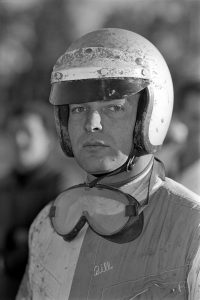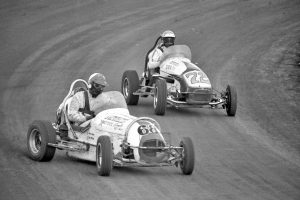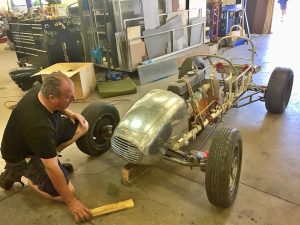A CAR / DRIVER AND PAGE IN HISTORY
A CAR/ DRIVER AND PAGE IN HISTORY
Vintage Speedway . . .
In addition to this website providing a daily world news updated service, we have a platform for today’s vintage divisions and Australian speedway history.
This website is as much for history, vintage clubs, events and articles on restored bikes/cars as it is a daily world news website.
The following article, by Vintage Speedcar Association of NSW newsletter editor KEITH NICHOLLS, traces the history of Australian Speedcar driver Billy Humphries who may have “slipped though the cracks” owing to his departure from the national scene in 1962. His objective was to establish himself on the professional American Speedcar circuit, while in 1968 the Victorian star returned home and raced at the Sydney Showground and also Liverpool Speedway. His performance at the Sydney Showground was plagued by engine problems but at Liverpool his style and professionalism shone through. In the short-period he competed at Liverpool before returning to America, he was a winner.
The second part of this story focuses on the restoration and history of Bill Humphries’ car USA #72 Offenhauser that he brought with him during his Australian visit in 1968.

Billy Humphries ventured where few had gone before him at that time.
It was a very different world back in the early sixties when Victorian Speedcar star Billy Humphries packed up and moved from his Australian comfort zone to take on the rigours of American open cockpit highly competitive professional Speedcar racing.
It was not just for a few weeks or a month, Billy was in for the long haul with a commitment to live and race in America.
It was a massive call!
Back in the day, communication, transportation – even motivation – was not what it is today. America is now within easy distance via a 14 and-a-half-hour non-stop jet flight. America back in dim dark decades of the long lost past might as well have been located on the dark side of the moon – it seemed that far away and beyond reach!
To up stakes, say goodbye to loved ones and the Australian way of life, leaving a local racing scene he had mastered and, then start all over again, was more than an objective but, in many ways, a battle against the odds.
It meant being thrown head-first at the deep end to either sink or swim against the red hot cauldron of the American racing scene driven by Billy on the whim of anticipation and expectation.
It took a bit of doing – not to mention guts.
Former Sydney driver Rob Greentree also tried it; Billy and Rob could be considered pioneers ahead of today’s stars who race in Australia one day, then jump on a plane, and two days later line up for a Speedcar, Sprintcar or Sedan race in America.
KEITH NICHOLLS has delved into the life and times of Billy Humphries.
The American class room and school of hard knocks honed his skills, he looked the part and filled the image of the all-American boy originally out of Melbourne upon his short return to Australia in 1968!
Although his visit was initially hampered by engine problems he showed enough he was now a pukka ‘take no prisoners’ racer.
He clearly possessed the skills and intellect gained from the rigours of a life on the road in the American fast lane.
Here’s KEITH NICHOLLS’ story . . .
THE BILL HUMPHRIES USA # 72 KURTIS KRAFT OFFY

Over some years I have had conversations with fellow VSA of NSW member Andrew Haliday and often talked about old cars and, of course, the ex-Billy Humphries car #72 Offy was part of these conversations. Most club members know that Andrew is well in the process of restoring this iconic car.
On a non-related subject Andrew sent me some photos of the old twin speedcar of Eddie Dark’s workshop that goes back to the late 1940s as his father Don, had restored the Jap 8/80 and thought we might like to include in the newsletter.
I sent Andrew an e-mail copied on top of his e-mail he had sent me on the Jap 8/80 indicating that I would like more information on your restoration. What happens next was I received an e-mail back from Andrew all about car #72 so, boy, do we have our wires crossed!
However we immediately had the nucleus of a very interesting story.
We begin the journey at Victoria’s Tracey’s Speedway (in Melbourne) and finish at Andrew Halliday’s residence with the restoration in progress.
At Tracey’s Speedway during the late 1950s early 1960s the likable Bill Humphries was learning the craft of Speedcar racing at Tracey’s Speedway during the late 1950s – early 60s.
It was during this era that American legend Bob Tattersall came to Australia and in the 1960-61 season at Tracey’s Speedway Bill got the chance to race against this high profile visitor. During the race Bill made a good account of himself by finishing fourth behind Jack O’Dea with Bruce Rickard in second and winner Bob Tattersall.
This probably was the catalyst for Bill to make plans to visit America.
During the 61-62 speedway season Bill came to Sydney for a crack at the big time Sydney Showground and was one of several Victorian drivers who would made the trek to have a run at the iconic Sydney venue under the big lights. Like a lot of interstate drivers, Bill had to come to grips with running on the somewhat narrow 1/3 mile track with Colosseum of huge crowds that was so much different to the Tracey and Adelaide’s Rowley Park 1/4 milers, however he managed to adapt to this new environment.
Bill Humphries was a very capable driver on his home turf and had considerable success driving Vic #55, a Holden powered Kurtis Kraft copy on torsion bars owned and built by Len Fleming.
A list of Bill Humphries achievements at Tracey Speedway:
January 11, 1964 – The Alf Beasley Memorial placed . . . 3rd.
March 14, 1964 – The 25 lap Australian Derby placed . . . 1st.
March 21, 1964 – The 50 lap Golden Fleece Grand Prix . . .1st.
During the 1967-68 season The Alf Beasley Memorial race was won by Bill Humphries however the track location was not noted, but it was most probably run at Melbourne’s Brooklyn Speedway as the previous season’s meeting was held at Brooklyn.
It was during the mid 1960s Bill announced that he was leaving Australia for the United States where he would try his hand on the American speedway circuit, this, of course, was a huge commitment. Other Australians had it on their to-do list, but it was Bill who just got up and did it.
The speedway world in Australia during during what is often referred to as “The Golden Era” was flat out and Bill simply left all that behind. He spent several years racing on the USAC and AMRC circuits and was probably not missed that much here except by close friends, family and loved ones.Then in 1968 Bill Humphries returned to race at Sydney Showground and Liverpool Speedway. He brought with him a beautifully built and prepared Kurtis Kraft Offy powered Midget. Car was a stunner and numbered 72.

Bill Humphries had learnt his craft well whilst in the ‘States, and now presented as a very professional racing outfit and was promoted well by Liverpool Speedway where he displayed some fine driving during his visit.
Later on prior to Bill returning to the ‘States he sold his car to Eric Morton.
Eric Morton set about successfully sorting out the Offy. It was later re-painted a beautiful iridescent blue and, with Lew Marshall at the helm in 1968, they won the NSW Speedcar Championship at the Sydney Showground. The car was now the top car in Eric’s stable.
Eric’s #72 was later instrumental in advancing the career of Barry Pinchbeck both on the dirt and then the pavement track at Liverpool.
Bill Humphries’ American highlights, early 1970s . . . taken from the American publications of the day:
At Angell Park Speedway, Wisconsin the following is from the “Star Countryman” August 9, 1973 edition and reads “AUSTRALIAN BILL HUMPHRIES NABS TWO FEATURE WINS!”
“Bill Humphries, Sydney Australia turned bad luck into good at Angell Park Sunday night. Bill driving a car he bought on Thursday after crashing his own on Wednesday, won both the trophy dash and feature event.
“Humphries starting on the 4th row outside worked his way steadily through the field taking the lead from Dave Ray on lap-7 of the 25-lap feature.
“The yellow flag came out on Lap-9 as Lars Leinster in “The Advance Transportation Special” came into the pits on fire. The fire was quickly extinguished and both the car and Lars were unhurt.
“When racing under the green resumed, point leader John Hartwig tried unsuccessfully to catch the flying Australian and finished 2nd Dave Ray was 3rd and George Carey was 4th.”
Results: Time trials 35 cars . . . 1st Terry Vaughn, 17.038 2nd George Carey, 17.256 3rd Bill Humphries, 17.304
Trophy Dash: 1st Bill Humphries, : 2nd Rich Vogler, 3rd John Hartwig
Heat 1: 1st Bob Walldan, 2nd Kevin Olsen, 3rd Bill Humphries.
Feature: 1st Bill Humphries, 2nd John Hartwig, 3rd Dave Ray.
Billy Humphries was a pioneer and successful driver who committed to the task of driving well. To many people, not much is known about him, I hope we have done Bill proud by bringing to light his story and to the task that Andrew Halliday has in restoring Bills car.
The Andrew Halliday Restoration
Andrew Halliday: ”Don Halliday first found out that #72 was for sale while we were at Waikerie Speedway in South Australia; this was at the time when returning from Adelaide after purchasing the ex-Jack Brabham car 28 twin.
“I bought 72 from Murray Williams as a pile of rubble in Adelaide during Easter of 1984 and in the afternoon went to Dean Hogarth’s place to purchase more parts. This was before heading back to Mt Gambier Speedway to watch the semi-main and feature events as we had been crewing for Bob Blacklaw on the Easter Sprintcar trail. For the next couple of years this would become a pilgrimage for David and I.
“The 72 car was last raced around 1981 by Brian Mullins, the car was badly bent, Sid Middlemass made an attempt at straightening the chassis however it cracked. Then it would be moved around the yard for the next five years as half a chassis, being moved from here to there. In the meantime I would buy the missing pieces for 72 that had been scavenged before I purchased the car.
“Peter Cunneen welded the new front piece from the firewall forward on 72 and Richard Bednarz would straighten the chassis.
If I had to do it again I would replace the whole bottom two rails. Over the years work was done on the car a bit here and there, and finally now it has become rolling chassis.”
2016
“I was reading an add in the Oilyrag magazine for the HSRCA club about a business starting called Motorretro; it’s a place you could learn welding and fabrication. I became their first student and have been going on and off on Tuesday nights and Saturdays for the last couple of years. For my first job, I made a Kurtis Kraft fuel tank for David`s Offy followed by the side panels for my Cooper mk4.
“I then copied 72’s fiberglass nose as a novelty and decided why not go full aluminium body for 72.
“Phillis Morton said that To Eric 72 ‘was the car like Cal Niday’s Number 3 Offy that he saw back in the 40s and always wanted a car like it.’ “The original tail has just been fully repaired by me doing 90% of the work with my school teachers doing the last 10%. Currently I can’t attend school due to Coronavirus so I have been working on the front and rear bars and also the nerf bars.
“The original tail has just been fully repaired by me doing 90% of the work with my school teachers doing the last 10%. Currently I can’t attend school due to Coronavirus so I have been working on the front and rear bars and also the nerf bars.
“There have been many other distractions. I have had Go-Kart and historic racing, surfing, trips to England and France, plus chasing women at rock concerts with David, plus swap meetings and going to the speedway, just to name a few.
“The car will be finished in two weeks, give or take another two weeks as they say. I hope to have it running one day with a Datsun engine as it did in 1969-70 and for displays featuring the aluminium nose and bonnet.
“Car 72 will never be finished until I have my own Offenhauser engine for it and will not be eligible for restoration of the year until then.”





CARDIFF’S 2025 GP WITHDRAWAL